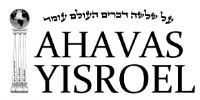Kitzur Shulchan Aruch, Rabbi Shlomo Ganzfried
Halacha Club. Join the club. Learn the Law!
Chapter 81 : The Four Domains With Regard to Shabbos
§1
There are four classes of domains with regard to the laws of Shabbos: private domain, public domain, karmelis and makom petur. We shall explain them briefly.
§2
What is a private domain? It is a place that is at least four tefachim by four tefachim (which is sufficiently significant to be of use) and is surrounded by partitions at least ten tefachim high (even if the partitions are not complete). A trench, ten tefachim deep and four tefachim wide, has the same halachah as a partition. Similarly, the same is true of a hole ten [tefachim] deep, and four tefachim by four tefachim wide, and also a mound ten tefachim high and four tefachim by four tefachim wide. Even a vessel such as a box, if it is ten [tefachim] high, or a round barrel that is large enough to circumscribe a four by four square; all of these, even if they are in a public domain or in a karmelis, are considered separate premises of their own and constitute a private domain. The open space over a private domain is considered a private domain until the sky. The tops of the walls that surround a private domain, are also considered a private domain. If there are holes in the walls on the side facing a private domain, even if they run through from side to side, since they can be used from the private domain, they are insignificant in comparison to the wall [and therefore] are considered as a private domain. (When the holes are only on the outside of the wall, this will be explained in the following paragraph.)
§3
What is a public domain? Streets and market squares that measure sixteen amos by sixteen amos are considered public domains, for this was the width of the road in the camp of the Levites in the desert: And highways by which people travel from city to city that are sixteen amos wide are [also] public domain. Anything in a public domain that is less than three tefachim above the ground, even thorns or dung on which most people do not step, is nevertheless insignificant when compared to the ground, and is considered part of a public domain. Likewise, a ditch in a public domain; that is less than three tefachim deep, is considered public domain. The holes in the walls facing a public domain that do not run through to a private domain, and are lower than three tefachim from the ground, are insignificant compared to the public domain, and are considered public domain. However, if they are higher than three tefachim [from the ground], we must consider them according to their dimensions. If the hole measures four by four tefachim but is lower than ten tefachim, it is considered a karmelis; if it is higher than ten tefachim, it is a private domain. If it is less than four by four tefachim it is a makom petur, whether it is above ten tefachim or below ten tefachim [from the ground]. Alleys that lead into a public domain are sometimes regarded as public domain and sometimes as karmelis. This involves many intricate halachic details. Some authorities say, that any place through which fewer than 600,000 people pass daily, as was the number of Jews in the desert, is not a public domain, but is regarded as a karmelis. Therefore, nowadays, we have no public domain. Every God-fearing person should follow the more stringent view.
§4
What is a karmelis? It is any place that is not a public thoroughfare, and is not properly surrounded by partitions such as a field; or a stream that is no less than ten tefachim deep and no less than four tefachim wide; and alleys that have three partitions. Also an itztavanis, (which is a place in front of shops where merchants sit) or an itztaba, (a stand on which merchandise is placed,) in front of the pillars in the public domain, and [the itztaba] is four tefachim wide and from three tefachim to ten tefachim high. Also a place that measures four [tefachim] square, and is surrounded by partitions that are less than ten [tefachim] high; and a mound that measures four [tefachim] square and from three to ten [tefachim] high; and a pit that measures four [tefachim] square and is from three to ten [tefachim] deep. There are also many other examples of karmelis. (The word karmelis is a composite of rach and mol, which means, neither wet nor dry, but in between. The same applies in this case; it is neither a private domain, because it does not have proper walls, nor is it public domain, because not many walk there.)
§5
What is a mekom petur? It is any place in a public domain that does not measure four [tefachim] square and is more than three [tefachim] high; or a pit that is not four [tefachim]] square and is deeper than three [tefachim]; and a place that does not measure four [tefachim] square but is surrounded by partitions of three or more [tefachim] high. All these places [are exempt] only when they are in a public domain, [for then] they are considered a mekom petur. But when they are in a karmelis, they are also considered part of karmelis.
Daily Tehillim Effort
The world is in serious trouble...
We can try to help it by collectively saying the entire sefer Tehillim daily. Click the link to select one or more to participate.

Please sign up to say a portion of Tehillim daily.
We are trying to have the whole Sefer Tehillim said daily as a z'chus for the safety of the Jews in Eretz Yisroel.
Useful Links
Our Contacts
Oak Park, MI 48237
Phone: 248-229-9320
Email: learn.torah.ahavas@gmail.com